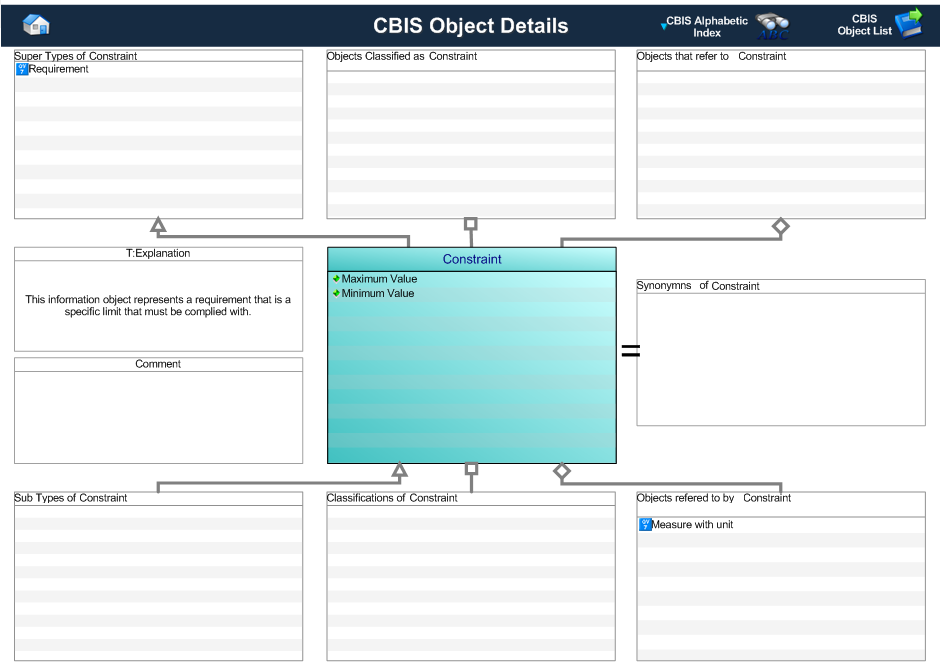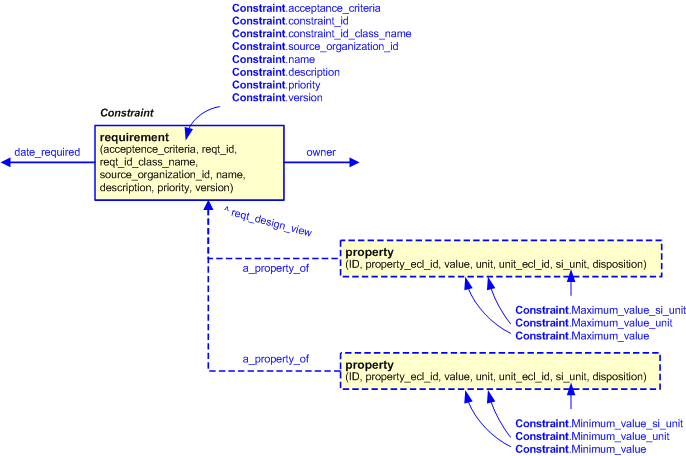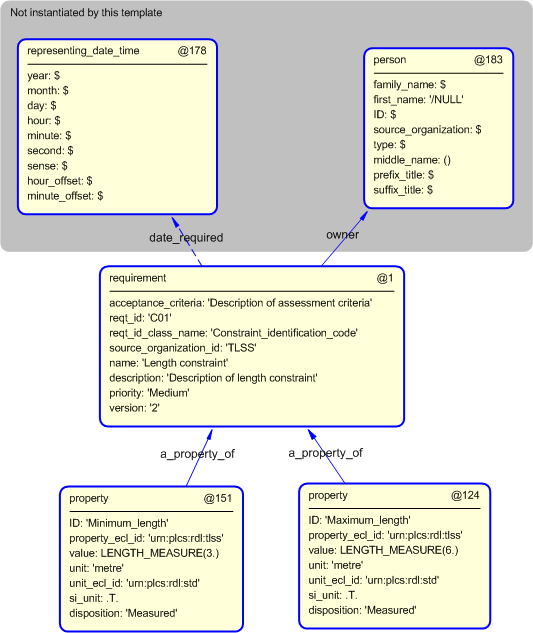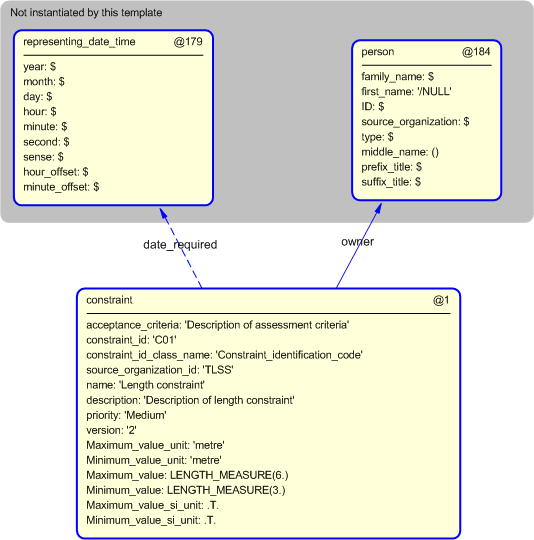Template:— constraint (cnstrnt)
Context:— UK_Defence |
Date: 2009/04/17 10:56:16
Revision: 1.5
|
This section specifies the template constraint.
NOTE
The template has been defined in the context of
UK_Defence.
Refer to the business context for details of related templates.
NOTE
An explanation of a template and the associated instantiation path is
provided in the
Template overview
section.
This template describes how to represent a requirement that sets specific limits that must be complied with.
This template describes how to represent UK_Defence constraint using
Requirement
This information object represents information about a type of requirement that sets specific limits that must be complied
with.
The EXPRESS-G diagram in
Figure
2
shows the templates and EXPRESS entities that are required
to represent the template
"constraint".
The text highlighted in blue shows the template parameters.
Figure 2 — An EXPRESS-G representation of the Information model for constraint
The graphic for the template to be used in other EXPRESS-G diagrams
is shown in Figure
3
below.
Figure 3 — The graphical representation of the constraint template
The following input parameters are defined for this template:
The class name corresponding to the unit in which the maximum value of the constraint is measured.
The following classes and their sub-classes can be used:
The class name corresponding to the unit in which the minimum value of the constraint is measured.
The following classes and their sub-classes can be used:
The maximum value of the constraint.
The data type must also be indicated in this parameter, e.g.
"ANY_NUMBER_VALUE(5)".
The maximum value of the constraint.
The data type must also be indicated in this parameter, e.g.
"ANY_NUMBER_VALUE(5)".
Value should be set to true if the unit is a SI base unit defined by ISO, i.e.
kilogram (kg) for Mass,
second (s) for Time,
metre (m) for Displacement,
ampere (A) for Electrical current,
kelvin (K) for Temperature,
mole (mol) for Amount of substance, and
candela (cd) for Luminous intensity. If this is not the case it should be set to false.
Note that the representation of true and false depends on exchange format. In Part 11 (a STEP file) true is
represented by the string ".T.", and false by ".F.", while in Part 28 (XML) they are represented by text strings
"true"
and "false".
Value should be set to true if the unit is a SI base unit defined by ISO, i.e.
kilogram (kg) for Mass,
second (s) for Time,
metre (m) for Displacement,
ampere (A) for Electrical current,
kelvin (K) for Temperature,
mole (mol) for Amount of substance, and
candela (cd) for Luminous intensity. If this is not the case it should be set to false.
Note that the representation of true and false depends on exchange format. In Part 11 (a STEP file) true is
represented by the string ".T.", and false by ".F.", while in Part 28 (XML) they are represented by text strings
"true"
and "false".
The following reference parameters are defined for this template:
Allow the
Requirement
entity instantiated in this path to be referenced when this template is used.
Note: The
Requirement
entity can be referenced in a template path by:
%^target = $constraint.constraint%
where
target
is the parameter to which the
Requirement
is bound.
Allow the
Requirement_version
entity instantiated in this path to be referenced when this template is used.
%^target = $constraint.constraint_version%
%^target = $constraint.constraint_design_view%
%^target = $constraint.constraint_design_contxt%
The instantiation path shown below specifies the entities that are to be
instantiated by the template.
A description of templates and the syntax for the instantiation path is
provided in the
Templates Help/Information section.
-- Constraint -- [optional date_required] /
requirement(
acceptance_criteria=@acceptance_criteria,
reqt_id=@constraint_id,
source_organization_id=@source_organization_id,
name=@name,
description=@description,
priority=@priority,
version=@version,
owner=@owner,
date_required=@date_required)/
-- rename reference parameters %^constraint = $requirement.reqt%
%^constraint_version = $requirement.reqt_version%
%^constraint_design_view = $requirement.reqt_design_view%
%^constraint_design_contxt = $requirement.reqt_design_contxt%
-- Maximum value /
property(
a_property_of=^constraint_design_view,
ID='Maximum_value',
property_ecl_id='urn:plcs:rdl:uk_defence',
value=@Maximum_value,
unit=@Maximum_value_unit,
unit_ecl_id='urn:plcs:rdl:std',
si_unit=@Maximum_value_si_unit,
disposition='Measured')/
-- Minimum value /
property(
a_property_of=^constraint_design_view,
ID='Minimum_value',
property_ecl_id='urn:plcs:rdl:uk_defence',
value=@Minimum_value,
unit=@Minimum_value_unit,
unit_ecl_id='urn:plcs:rdl:std',
si_unit=@Minimum_value_si_unit,
disposition='Measured')/
The instance diagram in Figure
4
shows an example of the EXPRESS entities and templates that are instantiated by the template:
/constraint(acceptance_criteria='Descriptions of assessment criteria', constraint_id='C01', source_organization_id='UK_Defence', name='Length constraint', description='Description of length constraint', priority='Medium', version='2', Maximum_value_unit='metre', Minimum_value_unit='metre', Maximum_value='6', Minimum_value='3', Maximum_value_si_unit='true', Minimum_value_si_unit='true', date_required='@179', owner='@184')/
(an illustration of the consolidated constraint template is shown in
Figure
5 below.)
Figure 4 — Entities instantiated by constraint template
The instance diagram in
Figure
5
shows the graphic symbol for the template that is to be
used in other instance diagrams. The example template is:
/constraint(acceptance_criteria='Descriptions of assessment criteria', constraint_id='C01', source_organization_id='UK_Defence', name='Length constraint', description='Description of length constraint', priority='Medium', version='2', Maximum_value_unit='metre', Minimum_value_unit='metre', Maximum_value='6', Minimum_value='3', Maximum_value_si_unit='true', Minimum_value_si_unit='true', date_required='@179', owner='@184')/
Figure 5 — Instantiation of constraint template
Characterizations
No common characterizations of the template
constraint
have been identified. However, the ISO 10303-239 EXPRESS model
may enable other assignments to the entities instantiated by the template.




